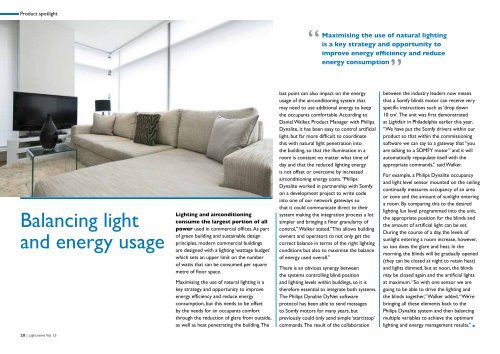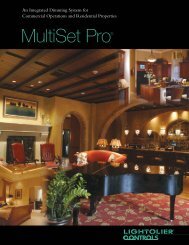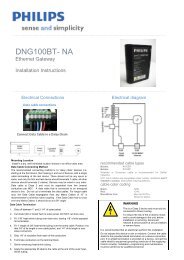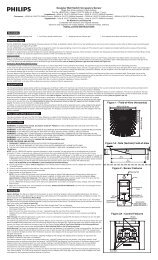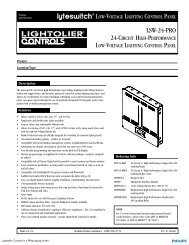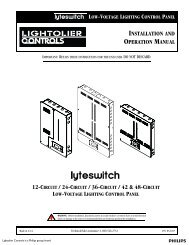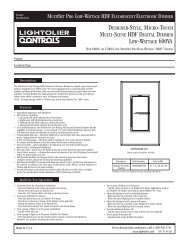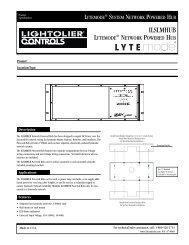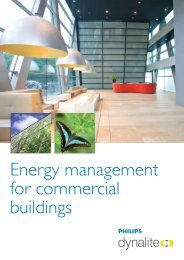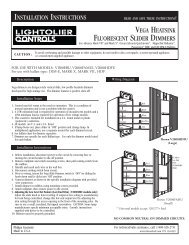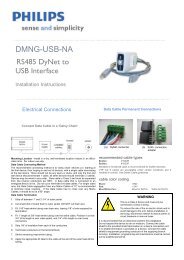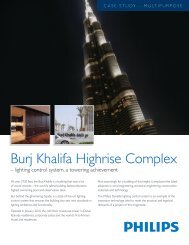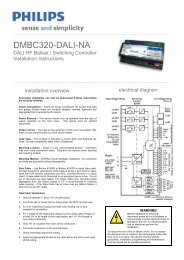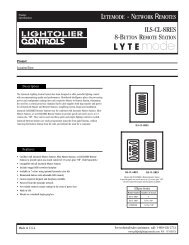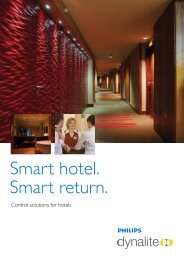Lightnews Vol 13.pdf - Philips Lighting Controls
Lightnews Vol 13.pdf - Philips Lighting Controls
Lightnews Vol 13.pdf - Philips Lighting Controls
You also want an ePaper? Increase the reach of your titles
YUMPU automatically turns print PDFs into web optimized ePapers that Google loves.
Product spotlightMaximising the use of natural lightingis a key strategy and opportunity toimprove energy efficiency and reduceenergy consumption“”Balancing lightand energy usage<strong>Lighting</strong> and airconditioningconsume the largest portion of allpower used in commercial offices. As partof green building and sustainable designprinciples, modern commercial buildingsare designed with a lighting ‘wattage budget’which sets an upper limit on the numberof watts that can be consumed per squaremetre of floor space.Maximising the use of natural lighting is akey strategy and opportunity to improveenergy efficiency and reduce energyconsumption, but this needs to be offsetby the needs for an occupants comfortthrough the reduction of glare from outside,as well as heat penetrating the building. Thelast point can also impact on the energyusage of the airconditioning system thatmay need to use additional energy to keepthe occupants comfortable. According toDaniel Walker, Product Manager with <strong>Philips</strong>Dynalite, it has been easy to control artificiallight, but far more difficult to coordinatethis with natural light penetration intothe building, so that the illumination in aroom is constant no matter what time ofday and that the reduced lighting energyis not offset or overcome by increasedairconditioning energy costs. “<strong>Philips</strong>Dynalite worked in partnership with Somfyon a development project to write codeinto one of our network gateways sothat it could communicate direct to theirsystem making the integration process a lotsimpler and bringing a finer granularity ofcontrol,” Walker stated.”This allows buildingowners and operators to not only get thecorrect balance in terms of the right lightingconditions but also to maximise the balanceof energy used overall.”There is an obvious synergy betweenthe systems controlling blind positionand lighting levels within buildings, so it istherefore essential to integrate both systems.The <strong>Philips</strong> Dynalite DyNet softwareprotocol has been able to send messagesto Somfy motors for many years, butpreviously could only send simple ‘start/stop’commands. The result of the collaborationbetween the industry leaders now meansthat a Somfy blinds motor can receive veryspecific instructions such as ‘drop down10 cm’. The unit was first demonstratedat Lightfair in Philadelphia earlier this year.“We have put the Somfy drivers within ourproduct so that within the commissioningsoftware we can say to a gateway that “youare talking to a SOMFY motor” and it willautomatically repopulate itself with theappropriate commands,” said Walker.For example, a <strong>Philips</strong> Dynalite occupancyand light level sensor mounted on the ceilingcontinually measures occupancy of an areaor zone and the amount of sunlight enteringa room. By comparing this to the desiredlighting lux level programmed into the unit,the appropriate position for the blinds andthe amount of artificial light can be set.During the course of a day, the levels ofsunlight entering a room increase, however,so too does the glare and heat. In themorning, the blinds will be gradually opened(they can be closed at night to retain heat)and lights dimmed, but at noon, the blindsmay be closed again and the artificial lightsat maximum. “So with one sensor we aregoing to be able to drive the lighting andthe blinds together,” Walker added, “We’rebringing all these elements back to the<strong>Philips</strong> Dynalite system and then balancingmultiple variables to achieve the optimumlighting and energy management results.” n28 | <strong>Lightnews</strong> <strong>Vol</strong> 13


